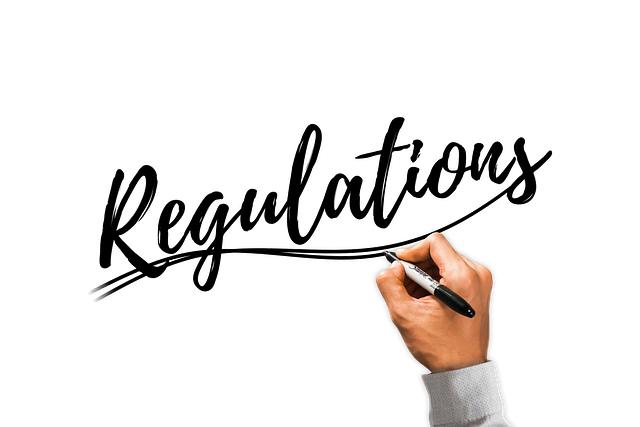In the intricate dance of global finance, regulations serve as the rhythm that ensures harmony and stability. Yet, when the music is ignored, and the steps falter, the consequences can be both immediate and far-reaching. In the world of financial regulations, compliance is not merely a suggestion but a mandate that safeguards the integrity of markets and the trust of investors. This article delves into the cascading repercussions that ensue when entities, whether through negligence or willful defiance, fail to adhere to these critical guidelines. From crippling fines and reputational damage to the broader implications for economic stability, we explore how the failure to comply with financial regulations can unravel the very fabric of financial systems, leaving behind a trail of disruption and uncertainty. Join us as we navigate the treacherous waters of non-compliance and underscore the paramount importance of upholding the laws that govern the financial world.
The Ripple Effect of Non-Compliance on Financial Stability
When financial institutions choose to bypass or inadequately adhere to regulations, the consequences can ripple across the entire economic landscape, destabilizing markets and eroding investor confidence. Non-compliance often leads to increased risk exposure, as unchecked practices may foster an environment where unethical behavior can thrive. This, in turn, can result in significant financial losses, not just for the institution involved but also for stakeholders and the broader economy. As trust diminishes, the cost of capital may rise, and market volatility can increase, making it difficult for businesses to plan and grow sustainably.
Moreover, the repercussions of non-compliance extend beyond immediate financial losses. Key impacts include:
- Legal Penalties: Institutions may face hefty fines and legal action, draining resources and damaging reputations.
- Operational Disruptions: Regulatory breaches often necessitate comprehensive audits and restructuring, diverting focus from core business activities.
- Reputational Damage: Loss of trust among clients and partners can lead to a decline in business opportunities and market share.
- Systemic Risk: Widespread non-compliance can threaten the stability of the entire financial system, potentially leading to economic downturns.
Ensuring compliance is not merely a regulatory obligation but a strategic imperative to safeguard financial stability and foster long-term economic growth.

Navigating the Legal Maze: Understanding Penalties and Sanctions
In the intricate world of financial regulations, non-compliance can lead to a cascade of severe repercussions. Regulatory bodies are equipped with a vast arsenal of penalties and sanctions designed to enforce compliance and maintain market integrity. These can range from monetary fines to more stringent measures such as suspension of licenses or even criminal charges. Understanding the spectrum of potential consequences is crucial for any entity operating within the financial sector.
- Monetary Fines: Often the first line of action, these can be substantial enough to cripple financial stability.
- Operational Restrictions: Regulators may impose limitations on certain business activities, impacting growth and profitability.
- Reputational Damage: Public disclosure of non-compliance can erode trust and tarnish a company’s image.
- Legal Action: In severe cases, entities may face lawsuits or criminal charges, leading to imprisonment for individuals involved.
It is imperative for businesses to implement robust compliance frameworks and stay informed about regulatory changes. Proactive measures not only mitigate risks but also foster a culture of transparency and accountability.

Mitigating Risks: Proactive Strategies for Regulatory Adherence
In the intricate world of financial regulations, staying ahead of potential pitfalls requires more than just a reactive stance. Proactive strategies are essential for businesses aiming to maintain compliance and avoid the severe repercussions of regulatory breaches. Implementing a comprehensive risk management framework can serve as a fortress against non-compliance. This includes:
- Regular Audits: Conducting frequent internal audits to identify and rectify potential compliance issues before they escalate.
- Continuous Training: Ensuring that all employees are well-versed in the latest regulatory requirements through ongoing education and training programs.
- Technology Integration: Leveraging advanced compliance software to monitor and report financial activities, ensuring real-time adherence to regulations.
- Stakeholder Engagement: Actively involving stakeholders in compliance discussions to foster a culture of transparency and accountability.
By adopting these proactive measures, organizations not only safeguard themselves from the financial and reputational damage associated with regulatory violations but also position themselves as industry leaders committed to ethical and responsible business practices.

Cultivating a Culture of Compliance: Leadership and Accountability
In the intricate web of financial regulations, leadership plays a pivotal role in ensuring adherence and fostering a culture where compliance is not just an obligation but a shared value. Leaders must embody the principles they wish to instill, demonstrating a commitment to ethical practices and transparent operations. This involves setting clear expectations, providing ongoing education, and creating an environment where employees feel empowered to speak up about potential compliance issues. Without strong leadership, organizations risk developing a culture of complacency, where the consequences of non-compliance can be severe and far-reaching.
Accountability is the backbone of a compliant organization. It requires leaders to not only set the tone at the top but also to implement robust systems that track and measure compliance efforts. This includes establishing clear policies, conducting regular audits, and ensuring that there are consequences for failing to meet regulatory standards. When accountability is ingrained in the corporate ethos, it reduces the risk of regulatory breaches and enhances the organization’s reputation. Key elements of an accountable culture include:
- Transparent communication channels that allow for the reporting of compliance concerns without fear of retaliation.
- Regular training and updates on regulatory changes to keep all employees informed and prepared.
- Incentives for compliance that reward employees who consistently adhere to regulations and contribute to a culture of integrity.





